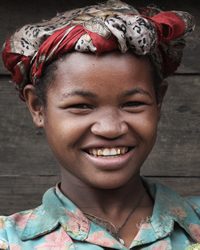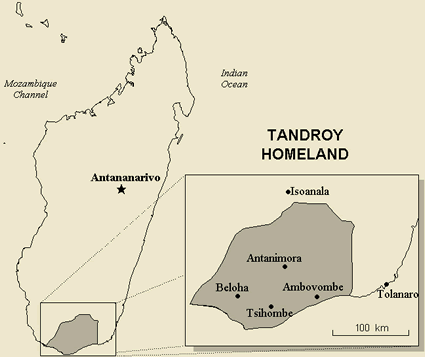The Tandroy people live in the arid extreme-South of Madagascar. The name Androy indicates the area where they live and means "where there are thorns", "roy" referring to a particular mimosa with long thorns (Mimosa delicatula). They have adapted to a very inhospitable environment, covered with thorny bush and plagued with drought. It is a constant struggle to find water and famine is regular. Their immediate neighbors are the Mahafaly (west), Bara (north) and Tanosy (east).
The Tandroy are usually tall and strongly built, known for their fierceness and self-assurance. They are intrinsically a pastoral people, but also cultivate manioc, millet, maize, and sweet potatoes. Their villages are hidden from the main road tracks, characteristically behind living fences of cactus. Their history has not yet been conclusively researched. The first written record referring to them as "Antandroy" is by Robert Drury (1729), recounting his fifteen years of captivity among them. According to oral history, different clans invaded Androy in the eighteenth century from the east, north and northwest and put an end to the ruling dynasty of the Andriamañare. The Tandroy remained divided into numerous small entities, sometimes uniting their forces against common enemies, maintaining their independence vis-a-vis the Merina until 1903 when French troops and administrators arrived. (Pearson, 1992).
There are today a substantial number of Tandroy living on just over 20,000 square kilometers between the Mandrare and Menarandra rivers. Many more are found in other parts of Madagascar where they migrate in search of work. Most of these migrants settle in separate communities, retaining their customs and return home after a few years. The migrations started in the 1920s and intensify during times of famine.
Scripture Prayers for the Antandroy in Madagascar.
| Profile Source: Anonymous |











